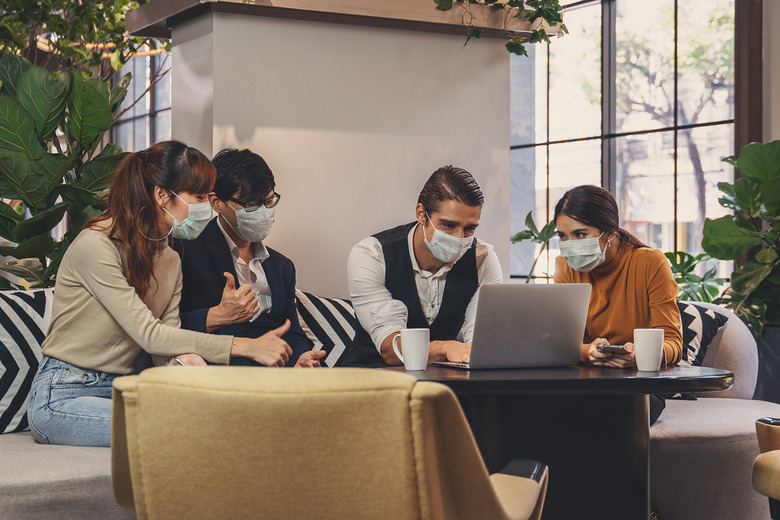The One Thing That Puts You At Risk Of Catching COVID-19 Even When You're Wearing A Mask
- Researchers from the American Institute of Physics performed face mask experiments that showed wearers might be doing something wrong that puts them at risk of coronavirus infection.
- The researchers showed that face mask use without social distancing is still a risky behavior, as particles expelled during sneezing and coughing can still infect nearby people.
- Health experts have been advising people to respect all COVID-19 prevention recommendations, including the use of face masks, social distancing, frequent hand hygiene, proper ventilation of indoor spaces, and avoiding crowded indoor spaces.
Health experts managing the novel coronavirus pandemic have been recommending the same precautions for many months to reduce the risk of COVID-19 infections. Social distancing and frequent hand washing were the measures people were advised to observe in the pandemic's early weeks. Face masks were then added to the list in early April. On top of that, experts then started telling people to avoid crowded indoor places during the summer and choose activities outdoors where the risk of catching COVID-19 was significantly reduced. As the cold season arrived, guidelines started to include the ventilation of homes to help remove aerosols and droplets that could carry the coronavirus, as well as the use of face masks even in your own home while in the presence of people from outside the household.
Social distancing, hand hygiene, and face covers are still the backbone of these recommendations, and these three things should be observed regardless of the season or location. We've often explained that all these measures are meant to complement each other. Each one adds another layer of safety, but they're not perfect solutions by themselves. A new study has just demonstrated that point, showing that there's one thing that you might be doing wrong that puts you at risk of infection even when you're wearing a mask — and even if the people around you wear masks as well.
Researchers from the American Institute of Physics published a paper in Physics of Fluids detailing experiments that showed social distancing is required even when wearing face masks to ensure the best possible protection.
The scientists wondered whether face masks could offer protection "from airborne sneeze and cough droplets in close-up, face-to-face human interactions" and went to work trying to measure the quantity of droplets that are spread around a person wearing a face mask when sneezing or coughing.
"During these close-up, face-to-face interactions, a common belief is that a susceptible person wearing a face mask is safe, at least to a large extent, from foreign airborne sneeze and cough droplets," the team wrote. "This study, for the first time, quantitatively verifies this notion."
"A mask definitely helps, but if the people are very close to each other, there is still a chance of spreading or contracting the virus," New Mexico State University associate professor Krishna Kota said in a statement. "It's not just masks that will help. It's both the masks and distancing."
The researchers built a machine that used an air generator to mimic human coughs and sneezes. The tiny particles were blown through "through laser sheets in an airtight square tube with a camera." They blocked the tube with five types of face masks, including an N95 respirator, surgical mask, two-layer cloth mask, wet two-layer cloth mask, and a regular cloth mask. The masks captured the vast majority of droplets. The cloth mask allowed 3.6% of the droplets to go through, and the N95 mask offered the best seal — it "statistically stopped 100% of the droplets," according to the news release.
At a distance of fewer than 6 feet, the droplets that do escape the masks might be enough to infect someone in the vicinity of the person sneezing or coughing. The team said that a single sneeze could carry up to 200 million tiny virus particles. Even if most of them are blocked by the mask, enough of them could escape it and infect other people.
Face masks are meant to provide dual protection. They'll stop most droplets and aerosols expelled as the wearer sneezes, coughs, and talks. But they'll also protect other people from the particles around them. A person wearing a mask who isn't able to also distance him or herself from others might still be at risk of infection.
"Without a face mask, it is almost certain that many foreign droplets will transfer to the susceptible person," Kota said. "Wearing a mask will offer substantial, but not complete, protection to a susceptible person by decreasing the number of foreign airborne sneeze and cough droplets that would otherwise enter the person without the mask. Consideration must be given to minimize or avoid close face-to-face or frontal human interactions, if possible."
The report also notes that the study did not consider leakage from masks, especially when they're not worn correctly. That could further increase the number of droplets that escape.
Even if all health precautions are observed all the time, there's still no guarantee that a person is 100% safe. Any tiny mistake might allow the virus to reach the inside of the nose, the first location inside the body where it starts multiplying. Vaccines will stop the virus from descending into the lungs and prevent severe COVID-19, but they won't prevent infections entirely or stop the spread of the disease.
The new face mask study is available in full at this link.
